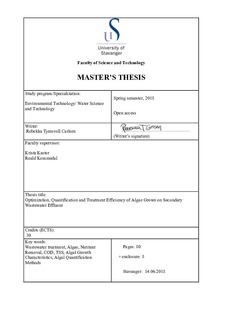| dc.description.abstract | The main objective of this project is to identify algal strains, which efficiently grow in the specific secondary wastewater effluent from IVAR Wastewater Treatment Plant (WWTP) at Grødaland. Algal cultivation will be optimized using different strategies including changing environmental factors such as light intensity, temperature, and mixing. It is essential that the algae simultaneously remove large amounts of nutrients, while producing algal biomass. To identify the best algal strains for wastewater treatment, the amount of nutrients, chemical oxygen demand (COD), alkalinity, and total suspended solids (TSS) will be measured before and after algal treatment. To accurately and effectively study the algal growth, it is fundamental to determine the most reliable and rapid quantification method. Therefore, algal enumeration based on flow cytometry, direct counting using counting chambers, microplate readings, and optical density (OD) measurements will be studied and compared.
The results indicated a good linearity for OD540, OD680, and OD750 measurements and flow cytometry for axenic cultures of C. vulgaris, C. sorokiniana, T. obliquus, and M. salina cultivated in MWC+Se (freshwater species) and L1 (marine species) growth media. For algae cultivated in wastewater the flow cytometer provided an accurate and reliable cell count, in addition to being an easy and rapid quantification method. For the most reliable result, one should conduct flow cytometry and direct counting with counting chamber simultaneously. Algal strains T. obliquus, C. vulgaris, and especially C. sorokiniana grew well in pure secondary effluent, achieving maximum growth rates of 1.28 d-1, 1.33 d-1, and 1.99 d-1, respectively. In wastewater diluted with unfiltered lake water, C. sorokiniana reached maximum growth rate of 2.06 d-1, followed by C. vulgaris with growth rate 1,60 d-1 and T. obliquus with growth rate 1.39 d-1. M. salina did not grow in pure wastewater, but grew well in wastewater diluted with filtered seawater with a growth rate of 1.55 d-1. The results indicated that applying algae T. obliquus and C. sorokiniana for wastewater treatment would result in great nutrient removal. T. obliquus removed 80% TP, 71% TN, and 70% NH4+, while C. sorokiniana removed up to 72% TP, 70% TN, and 73% NH4+. These algae also present effective biomass production of up to 1.35 g/L and 1.05 g/L, respectively. Based on growth characteristics, nutrient removal, and biomass productivity, C. sorokiniana and T. obliquus seems to be the best algal species to treat the mixed wastewater effluent from IVARs WWTP at Grødaland. | nb_NO |
